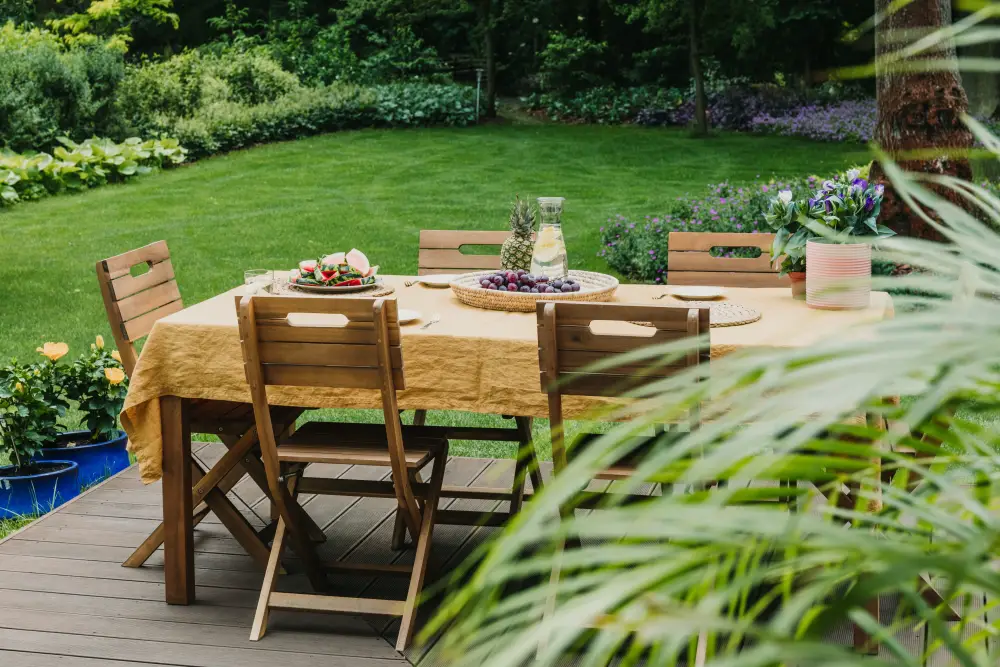Usually, when the nice weather is approaching, the concerns for landscaping, terraces and gardens start. But first of all, here's some information on how to protect the wood used in various outdoor landscaping or construction. We are talking about wood for garden furniture, wooden houses, terraces, gazebos, wooden street furniture. In order to withstand outdoor use, this wood needs to be finished. In outdoor wood projects, it is not primarily a question of aesthetics, but of finishes that are resistant to the sun's rays and weathering, which will protect the wood for as long as possible.

Which wood is best for landscaping and exterior works
In principle, any wood can be used outdoors. But certain species, because of their high tanninsThey are more resistant to weathering or solar radiation. One species widely used for garden furniture, swimming pools and outdoor terraces is teak-wood, an exotic, highly tannic wood. Teak also produces an oil that is used to protect other wood species.
The most tannin-rich local wood, with outdoor uses, even in the load-bearing structures of houses, is acacia. It's a very hard wood, so hard that it can damage and sometimes even break knives during mechanical machining processes. It is also very tannin, which makes it very resistant to the outdoors, even without special protection. I once saw a piece of acacia wood that had been sitting outside unprotected for more than 10 years. It was slightly blackened and looked moldy. Scraping it very lightly with a knife, I immediately reached the clean, healthy wood. The tannins contained in the acacia give it a particular smokiness. It can have green, orange and even purple iridescence. It is much used for garden furniture, but also for terraces.
Another species used outdoors is oak tree. Also a tannic wood, but not like acacia. Such woods are beautiful by nature and don't need special finishes to make them stand out. On the contrary, a discreet, protective finish is all it needs. Materials suitable for such a finish are oil and wax with outdoor resistance.
Oil and wax protection for exterior wood
The oils are absorbed into the wood, increasing its resistance to water. They give a "wet" look that brings out the natural design of the wood. The oil does not film, so the final look of oil-finished wood is very natural. For a long time, synthetic oils, those with petroleum derivatives as solvents, were used. Now, due to the general desire to protect the environment, water-dilutable oils have been developed with very good protective properties.
You can also use wax also for a natural-looking finish. There are solvent-based waxes and waterborne waxes. They can be colorless transparent or lightly colored. The totally colorless protects wood the least against UV radiation. If you add coloring pigments in wax, resistance increases.
Wax comes in several variations and can be applied by dipping, brushing or spraying. Single or multiple coats can be applied. Wax finishing has the advantage that, in addition to being water-resistant, it gives a very pleasant silky look and feel.
The oil or wax finish can be used for garden furniture, decking, paving, decking, arrow slates or other wooden structures.
If you want to find out more about the wood used in exterior projects and what finishes you can apply to it, you can check out the following the most resistant wood species for outdoor projects. Also the article with the most frequently asked questions about exterior wood protection can give you the answers you're looking for. And information about the best products to protect wood used in landscaping will help you make the best choices.
I hope you find the information useful. As always, additions are welcome. And if you have any questions or queries, please leave them below in the dedicated space. I will be sure to reply.




































Hello,
what do you think about lazuri? what are, in fact, these lazures? Are they lakes? Are they paints?
How well does it protect wood? In what situations are they used?
Thank you very much!
Good evening,
I wrote an article about the difference between lye, bait and paint. You can find it here. I hope it answers all your questions.
All the best!
Good evening
What do I use to protect the roofing under the metal tile?
Hello!
The asphalt is not exposed to the weather, so there is no need for exterior treatment.
Wood must be treated with solutions against decay and fire (fireproofing solutions).
Dry wood (8-12%) should be used. Wood with high moisture content is more prone to decay.
If the wood remains "exposed", it can be treated like any wood used for interior.
All the best!
Don't forget to subscribe to the printed Wood Magazine! For only 58 lei/year you can find out news in the field, discover craft ideas or trade secrets. We remind you that the content in the printed magazine is different from the one on the website. Details in the link below.
Thank you!
https://revistadinlemn.ro/product/abonament-revista-din-lemn/
Hello,
I have a very old wooden cart. I pressure washed it, now it looks like new. What can I protect it with, considering it will be outdoors all the time (rain, sun, wind, heat, frost, snow)?
Hello.
I would choose an oil or oil-based grease for outdoors. The oil is deeply absorbed and makes the wood very resistant to moisture. It does not film, so it is not affected by freeze-thaw cycles or dimensional variation of the wood due to outside moisture variation. In addition, it gives a rustic look which is very suitable for an old car.
The only disadvantage is the lower resistance over time compared to exterior varnishes. This means that every 2-3 years you will have to refinish. But it's very simple to do by applying another coat of oil. An indication that you need to refinish is the dry appearance of the wood. Over time the rains wash off the oil and the wood loses that silky sheen that the oil gives.
Outdoor oils or lazines you can also find in the shop Clever.
All the best!
Don't forget to subscribe to the printed Wood Magazine! For only 58 lei/year you can find news from
field, you can discover craft ideas or secrets of the trade. We remind you that in the magazine
printed content is different from that on the website. Details in the link below.
Thank you!https://revistadinlemn.ro/product/abonament-revista-din-lemn/
Hello,
Which oils do you recommend for outdoors?
For example, could I use linseed oil and over a varnish something?
Good evening.
The problems on the outside are mainly weathering and UV action. Linseed oil resists humidity very well, but has problems with UV radiation from the sun. To be resistant it must contain a small amount of pigments, i.e. it must be lightly coloured. It still remains transparent, but has a slight hint of colour. That's the oil-based varnishes you find on the market. Totally transparent oil does not last over time.
Teak oil, for example, is linseed oil coloured in the colour of teak wood.
There are also synthetic oils made especially for outdoors. They are contained in outdoor oil-based products.
In conclusion, you can use linseed oil on the outside if it is a little coloured.
All the best!
But how do we colour linseed oil?
Hello.
With pigments. An addition of 20% pigment in oil turns it into paint. Using 3-5% you get coloured lacquer.
To make the mixture as homogeneous as possible, after weighing, put all the pigment in a small amount of oil and mix well until it turns into a homogeneous paste. Then dilute with the rest of the oil. Below is a link where you can find the method described in detail.
All the best!
https://revistadinlemn.ro/2018/05/15/ulei-de-in-cand-unde-si-cum-se-foloseste-cum-sa-ti-faci-singur-vopsele-de-ulei/
I want to build a wooden staircase on the ground, with a handrail.What kind of wood is better and what should I do against rain, snow, sun, frost.I understand that the salcm is good for such a situation.
Thank you in advance and have a nice day!
Good evening!
Yes, salcam wood is a strong wood on the outside.
Below is a link to an article on exactly this topic. That is the most outdoor resistant species.
The best protection in this case is oil. It protects very well against moisture.
I've posted 2 more links related to finishing wood for the outdoors.
All the best!
https://revistadinlemn.ro/2019/06/12/cele-mai-rezistente-specii-de-lemn-la-exterior/
https://revistadinlemn.ro/2018/08/03/12-reguli-simple-pentru-a-avea-constructii-din-lemn-rezistente-la-exterior/
https://revistadinlemn.ro/2018/06/25/8-cele-mai-frecvente-intrebari-despre-protejarea-lemnului-la-exterior/
Hello!
I have purchased laminated spruce support posts for a patio. After sanding, what substances should I treat with?
Thank you
Hello!
If you want protection against mildew, fungi and insects, you should apply an insect-fungicidal impregnating coat. It provides protection against possible infestations, but not if the wood is already infested. It is not a compulsory treatment.
If you want the wood grain to be visible, apply coloured varnish. I do not recommend colourless varnish because it is not UV resistant. If you do not want the natural wood grain to be visible, apply exterior resistant paint.
I'm a fan of oil treatment on the outside, both as a varnish and paint. The oil protects very well from moisture and does not film. The advantage is that those that do film can crack over time and to restore, the cracked layer must be removed completely. In the case of oil, if it is removed in the weather, another layer can be applied without any further preparatory work.
If you don't want solvent-based products (such as oil) you can use water-based lacquers and paints. Such products can be found in DIY stores and are durable for 3-5 years, even longer.
All the best!
Thank you very kindly for your reply. Not being in the field, I would ask you briefly with common language. I was thinking one hand of Sadolin Base and two hands of Sadolin Extra. What do you think?
The manufacturer recommends 1-2 coats of Sadolin Base and 2-3 coats of Sadolin Extra. Sadolin Base is applied first and allowed to absorb well into the wood. Sadolin Extra is applied 24 hours after the last coat of Base.
In my opinion, it is good to apply 2 states of Sadolin Base. It penetrates the wood and protects it well against water. After that apply 2 coats of Sadolin Extra.
All the best!
Thank you very much
Hello!What do you recommend me to use for a patio built a few years ago and unpainted or lacquered, so something that I can use on old wood.Thanks!
Hello!
I would use oil for the exterior, i.e. grease or paint. The varnish is transparent and a little coloured to be resistant to solar radiation. It will look natural and will be very well protected from moisture.
Below are two links to newer and more extensive articles on exterior protection and one that is strictly about oil finishing. I hope you find them useful.
All the best!
https://revistadinlemn.ro/2018/06/25/8-cele-mai-frecvente-intrebari-despre-protejarea-lemnului-la-exterior/
https://revistadinlemn.ro/2018/08/03/12-reguli-simple-pentru-a-avea-constructii-din-lemn-rezistente-la-exterior/
https://revistadinlemn.ro/2019/04/17/7-reguli-de-respectat-la-finisarea-cu-ulei-a-lemnului/
How do I remove resin drips and drips from wood before applying protective oil?
Hello!
With white spirit (petrosin), turpentine oil, alcohol or universal thinner.
The problem is that if there are resin pockets in the wood, the resin will continue to flow after the oil is applied. In factories, the resin bags are removed and replaced with wooden 'dowel bars'. Nodes from which the resin drips can be sealed with shellac before the wood is oiled.
All the best!
What's with the background music, I don't see it, and so I can't turn it off, and because of that, I avoid your site, Honestly, it's a very elegant practice...Josnica... Yes... To have the music playing at full blast and we can't turn it off, Very bad of you, ..PS tested on three browsers and two different internet networks.
Thank you for pointing out the error. We can't figure out what it is. We also tested in Chrome and Safari and everything is OK. We suspect it is a video running inside the article. Can you confirm or deny this? If that's what it is, can you give us more details about the browsers and equipment (PC, phone, tablet) used?